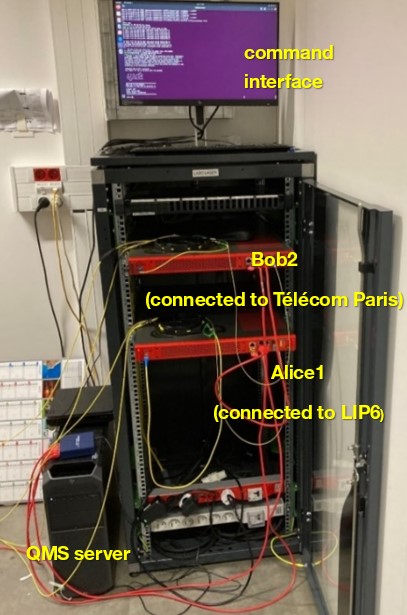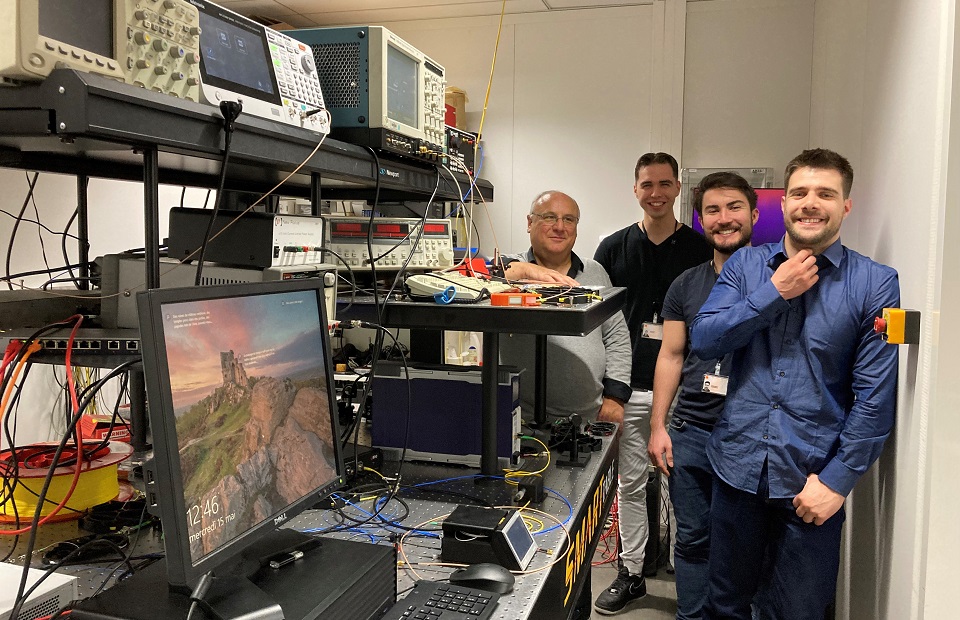• As part of the ParisRegionQCI project, a consortium of market players, university researchers and startups set out to prove the feasibility of quantum key distribution using existing terrestrial fiber networks — and succeeded.
• Thomas Rivera, a Research Project Manager at Orange with a PhD in optics and photonics, coordinated the project. He reflects on this major step forward for French quantum communications.
The word Quantum is on everybody’s lips; the “second quantum revolution” (following that of the 20th century) promises to exploit certain properties of matter on a micro level to improve the world on a macro one. Specifically, the research community is exploring the full extent of its possibilities in four areas of application: calculators, sensors, simulations and communications. In the field of quantum communications, we are already seeing promising signs of innovative quantum cryptography processes being implemented, based on the principle of quantum distribution of encryption keys (or “quantum key distribution”, ).
ParisRegionQCI has paved the way for quantum communications based on existing fiber network infrastructures.
Today, these techniques are within reach, but their cost is an early barrier to any large-scale implementation, unless, that is, they could be executed by reusing existing infrastructures. This was what the Paris Region Quantum Communication Infrastructure (ParisRegionQCI) project set out to prove, Thomas Rivera tells us.

The aim of the ParisRegionQCI project is to establish a quantum communication network in order to test secure communication solutions. What does this network involve?
To be more precise, what we want to do is establish a communication network that is compatible with quantum technologies because many of them, including the quantum computer, can make use of these networks. What we are talking about is a conventional network in which we have minimized the losses. This can be a fiber network or a free-space network (across the air or the space vacuum) in which everything has been adapted and optimized with a view to eliminating degradation that could hamper the useful properties of quantum physics, which are very sensitive to “noise.”
In quantum communication, the signal used to transport the key is extremely weak: every effort must be made to protect it from the external environment and disruptive random phenomena such as thermal agitation.
Do we need to roll out a specific fiber to guarantee these conditions, or can we rely on current infrastructures?
Quantum communication equipment is very expensive. Securing a link of less than 100 km on a dedicated fiber network would cost around €180–250K for the QKD system alone. The financial cost quickly becomes impossible. As part of the project, we have opted to use existing infrastructure. We started with conventional fibers that had already been deployed by Orange France, some of which are active and others dormant — waiting to be brought to life when customer needs require it. We have slightly adapted and qualified these fibers in terms of quality and performance to see how we can achieve the prerequisites of quantum communication for the purpose of transmitting QKD. In short, this involves taking measurements of the optical losses by sending packets of photons into the fiber and characterizing their roundtrips. Then, we deployed a quantum communication system in the field (developed by ID Quantique), we defined a seamless network architecture, added a layer of services, and implemented an encryption system adapted by Thales to accept these new quantum-generated keys.
Once the compatibility of these fibers with quantum communication had been established, you carried out the key exchange. What processes is it based on?
It should first be noted that the approach used for this project is based on a differentiated transmission of encryption keys and data to be encrypted, whereas other research, notably at Orange in Lannion, is focusing on co-propagation (more on that below).
In our case, the network dedicated to the key exchange ensures the proper transmission of these keys between two devices: on one side, the data is being encrypted and, on the other, it is being decrypted. The encryption key is generated using a Quantum Random Number Generator (QRNG). Picture this device as a tennis ball launcher, except that the balls are photons, which are launched toward a 50/50 beamsplitter and on exit are divided into two branches, according to the principles of quantum physics. At the end of these branches, they are then detected by photon detectors, ultimately generating bits (0 or 1) on an entirely random basis. A complex cryptographic protocol [BB84, see below] implements multiple QRNGs in QKD systems. This ultimately results in a tamper-proof cryptographic process, provided it is implemented using the technique, which is based on an encryption key that is larger than or equal to the message it protects.
The project was finalized in 2023. What are the major achievements and lessons learned?
The quantum fiber network we have built has a range of about 80 km. It interconnects several quantum nodes that are represented by the project partners, from the Plateau de Saclay (Thales, Institut d’Optique, Télécom Paris) to the Sorbonne University laboratory LIP6 in central Paris, via the Orange Gardens site in Châtillon. What the ParisRegionQCI has proved is that quantum communication—in this case, for the application of a QKD technology—is possible using or reusing previously deployed commercial fiber infrastructures, and this is a major step forward for the launch of a QKD service in France.

Trusted node in Orange Gardens at Châtillon with post quantum algorithm security and centralized server of the ParisRegionQCI network (QMS server).
The project also illustrates the dynamism of research in the field of quantum physics, and the synergy of different ecosystems. Our consortium has brought together major groups (Orange, Thales, Nokia), renowned quantum academic institutions such as LIP6 led by Eleni Diamanti, Télécom Paris’s LTCI (Information Processing and Communications Laboratory) represented by Romain Alléaume, and the Institut d’Optique led by Phillipe Grangier. This is in addition to startups such as Quandela, VeriQloud, KETS Quantum and CryptoNext, whose expertise and solutions have been invaluable.
What will happen to the network you have built?
The infrastructure was designed to last and to become part of a network that extends beyond the Paris Region. Through the initiative, EU Member States are committed to designing and building national quantum communication networks. Orange is piloting the work in France with the FranceQCI project, launched in 2023. The experimental network we have established will be part of this and has already been extended by 14 km as a result, to link up to the Materials and Quantum Phenomena Laboratory of the French National Center for Scientific Research (CNRS).
Moreover, it is also being partially reused by the École Normale Supérieure (Kastler Brossel Laboratory), LIP6 and the Parisian startup Welinq in the form of a quantum LAN to experiment with quantum memory concepts, an essential component of quantum communications of the future.


